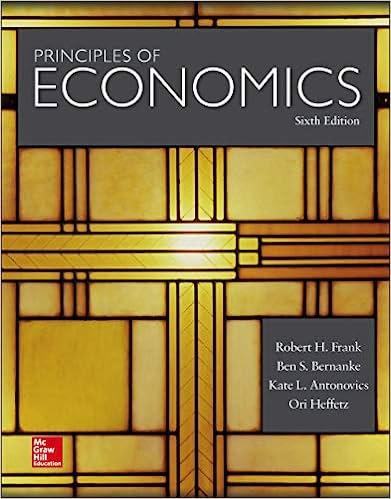Question
Assume that all prices and quantities are equal or more than 0. solve by substituting out the values to set x2 to a certain value
Assume that all prices and quantities are equal or more than 0.
solve by substituting out the values to set x2 to a certain value of x1 and same thing for price 1 and 2. Remember: budget constraint= p1x1+p2x2=m
A person's preference over services (good 1) and physical goods (good 2) is represented by the following Cobb-Douglas utility function:
u(x,y)=x^(1/3)*y^(2/3)
Throughout this problem, assume that the price of good 2 is p2=2
(refer to the properties of Cobb-Douglas utility)
Calculate the persons marginal rate of substitution.
Is the persons preference monotonic? Is it strictly convex? Show how
Do the indifference curves of the person'spreference intersect the good~1 axis or the good~2 axis (or both or neither)?Show how you got to the answer
For the rest of this question, assume the following. A person has income m=18to spend. But the government where the person lives has imposed a tax on physical goods (good 2) that works as follows: Each consumer can spend up to 10 on physical goods tax-free, but any additional spending on physical goods is taxed at a tax rate of 50%. Services are not taxed. Since the price of physical goods is p2=1 this means it faces the following budget constraint:
{p1x1+x2?18ifx2?10,
{p1x1+10+1.5(x2?10)?18ifx2>10,
Graph the budget constraint for this problem, making sure to put services on x axis and physical goods on y axis
It should be kinked
There are three corner candidates to consider as possible solutions to the choice problem, one at each intercept of the budget constraint and one at the kink. Which (if any) of these corner solutions can you eliminate before you even start to consider interior candidates? For each one, explain why or why not.
Solve the optimization problem. Explain how you found whether it is a corner solution or an interior solution
example below

Step by Step Solution
There are 3 Steps involved in it
Step: 1

Get Instant Access to Expert-Tailored Solutions
See step-by-step solutions with expert insights and AI powered tools for academic success
Step: 2

Step: 3

Ace Your Homework with AI
Get the answers you need in no time with our AI-driven, step-by-step assistance
Get Started


